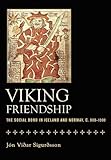Viking Friendship : The Social Bond in Iceland and Norway, c. 900-1300 / Jon Vidar Sigurdsson.
Material type: TextPublisher: Ithaca, NY : Cornell University Press, [2017]Copyright date: ©2017Description: 1 online resource (192 p.)Content type:
TextPublisher: Ithaca, NY : Cornell University Press, [2017]Copyright date: ©2017Description: 1 online resource (192 p.)Content type: - 9781501708480
- Friendship -- Iceland -- History -- To 1500
- Friendship -- Norway -- History -- To 1500
- Family & Relationships
- Medieval & Renaissance Studies
- Sociology & Social Science
- HISTORY / Medieval
- friendship vs. kinship, Iceland, Norway, early Scandinavian relationships, Icelandic family sagas
- friendship, kinship, social relationships, Viking society, Norse Middle Ages
- 305.3409481/09021 23
- DL460
- DL460 .J668 2017
- online - DeGruyter
| Item type | Current library | Call number | URL | Status | Notes | Barcode | |
|---|---|---|---|---|---|---|---|
 eBook
eBook
|
Biblioteca "Angelicum" Pont. Univ. S.Tommaso d'Aquino Nuvola online | online - DeGruyter (Browse shelf(Opens below)) | Online access | Not for loan (Accesso limitato) | Accesso per gli utenti autorizzati / Access for authorized users | (dgr)9781501708480 |
Browsing Biblioteca "Angelicum" Pont. Univ. S.Tommaso d'Aquino shelves, Shelving location: Nuvola online Close shelf browser (Hides shelf browser)

|

|

|

|

|

|

|
||
| online - DeGruyter Selling Hope and College : Merit, Markets, and Recruitment in an Unranked School / | online - DeGruyter The Despot's Guide to Wealth Management : On the International Campaign against Grand Corruption / | online - DeGruyter Two Weeks Every Summer : Fresh Air Children and the Problem of Race in America / | online - DeGruyter Viking Friendship : The Social Bond in Iceland and Norway, c. 900-1300 / | online - DeGruyter After Lavinia : A Literary History of Premodern Marriage Diplomacy / | online - DeGruyter Antifundamentalism in Modern America / | online - DeGruyter Thinking beyond the State / |
Frontmatter -- Contents -- Introduction -- 1. Friendship: The Most Important Social Bond in Iceland in the Free State Period -- 2. Friendship between Chieftains: “To His Friend a Man Should Be a Friend, and Repay Gifts with Gifts” -- 3. Kings and Their Friends -- 4. Clerics and Friendship -- 5. Friends of the Gods -- 6. Kinsmen and Friends: “Let There Be a Fjord between Kinsmen, but a Bay between Friends” -- 7. Friendship Loses Its Power: Political Changes in the Second Half of the Thirteenth Century -- 8. Pragmatic Friendship -- Notes -- Bibliography -- Index
restricted access online access with authorization star
http://purl.org/coar/access_right/c_16ec
"To a faithful friend, straight are the roads and short."—Odin, from the Hávamál (c. 1000) Friendship was the most important social bond in Iceland and Norway during the Viking Age and the early Middle Ages. Far more significantly than kinship ties, it defined relations between chieftains, and between chieftains and householders. In Viking Friendship, Jón Viðar Sigurðsson explores the various ways in which friendship tied Icelandic and Norwegian societies together, its role in power struggles and ending conflicts, and how it shaped religious beliefs and practices both before and after the introduction of Christianity.Drawing on a wide range of Icelandic sagas and other sources, Sigurðsson details how loyalties between friends were established and maintained. The key elements of Viking friendship, he shows, were protection and generosity, which was most often expressed through gift giving and feasting. In a society without institutions that could guarantee support and security, these were crucial means of structuring mutual assistance. As a political force, friendship was essential in the decentralized Free State period in Iceland’s history (from its settlement about 800 until it came under Norwegian control in the years 1262–1264) as local chieftains vied for power and peace. In Norway, where authority was more centralized, kings attempted to use friendship to secure the loyalty of their subjects. The strong reciprocal demands of Viking friendship also informed the relationship that individuals had both with the Old Norse gods and, after 1000, with Christianity’s God and saints. Addressing such other aspects as the possibility of friendship between women and the relationship between friendship and kinship, Sigurðsson concludes by tracing the decline of friendship as the fundamental social bond in Iceland as a consequence of Norwegian rule.
Mode of access: Internet via World Wide Web.
In English.
Description based on online resource; title from PDF title page (publisher's Web site, viewed 26. Apr 2024)


